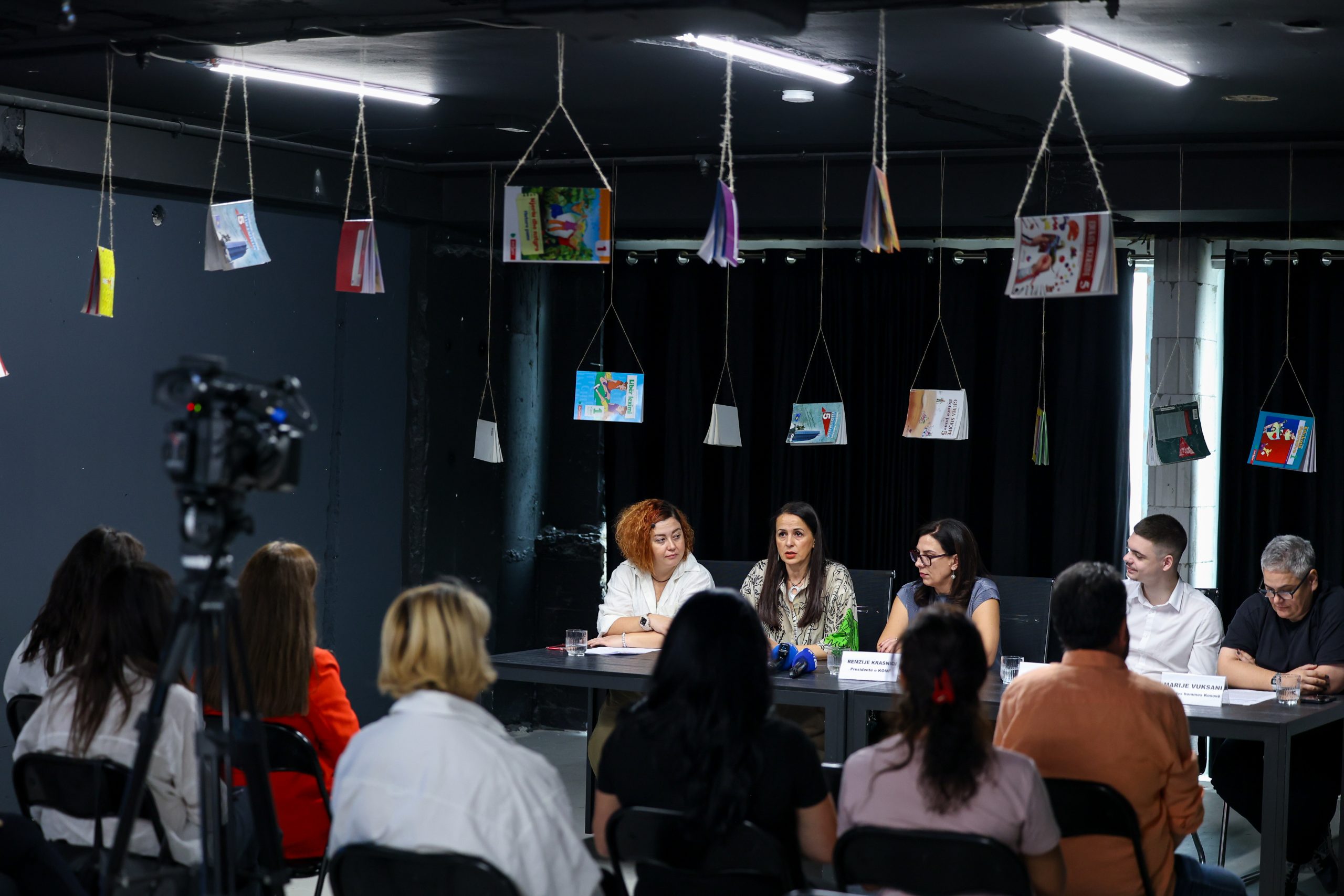
Education in free fall!
Coalition of NGOs for Child Protection – KOMF, held a media conference dedicated to education in Kosovo titled, “Education in free fall.” The panel, composed of KOMF members Remzije Krasniqi, KOMF President, Lulavere Behluli, Eldin Gashi, and Marija Vuksani, addressed their perspectives on the state of education in Kosovo, focusing on aspects such as quality in education, child protection in schools, inclusiveness, dropout prevention, as well as the innovations and challenges of the all-day learning model.

A total of 314,006 students are enrolled in Kosovo’s pre-university education system. This system is supported by an educational workforce of 27,710 individuals, of whom 22,836 are teachers. There are 1,036 public educational institutions across the country.
Pre-university education in Kosovo faces numerous challenges and problems that negatively impact the quality of education. The pass rate in the Achievement Test for this year is only 52.1%. According to the KOMF Monitoring Report “Report Card,” the work of public educational institutions in Kosovo was rated 2.5 on a scale from 1 to 5. Furthermore, the Programme for International Student Assessment (PISA) ranked Kosovo 76th out of 80 countries, indicating a low level of quality in education. Factors contributing to the low quality of education in Kosovo include: lack of adequate school infrastructure, the quality of teaching, the quality of textbooks, insufficient budgets for training, inappropriate teaching materials for the new curriculum, and a lack of mechanisms to ensure quality. Additionally, short school hours, an excessively high number of students in classes, an overloaded curriculum, schools with very few students in rural areas (including combined classes), lack of extracurricular activities, poor school management, the politicization of educational professionals, lack of cooperation among parents, teachers, and students, low accountability and frequent interruptions in the educational process (including strikes in education).

In addition to the low quality of education, public schools in Kosovo face other difficulties such as violence in schools and low inclusiveness. Public schools in Kosovo do not fully embody the concept of child-friendly schools, due to an unsafe and unfriendly environment, inadequate infrastructure, teacher attitudes, the lack of professional pedagogical and psychological staff in schools, and the lack of genuine cooperation with parents, among other issues. According to the Kosovo Police, there has been a significant increase in incidents of violence in schools compared to previous years. In 2022, a total of 592 incidents were reported in and around schools (in close proximity to school institutions). The Protocol for the prevention and referral of violence in pre-university educational institutions is only partially implemented. This is also evidenced by the very low number of reported violence cases in Education Management Information System (SMIA), where only 44 cases were reported in the 2022/23 school year.

Although continuous efforts are being made to realize the concept of inclusive education, this process encounters many difficulties as Kosovo is still in the phase of creating inclusive culture and practice, which requires human resources and sufficient funds. Important steps have been taken in policy advancement, attempting to include the concept of inclusiveness as an integral part of all educational policies. However, the implementation of these policies and the development of mechanisms that ensure inclusiveness remain a major challenge. Only 3,965 children with disabilities are included in regular classes.

Only 609 schools have access for children with disabilities. Inclusion of children with disabilities in schools is low and teaching is not based on the individual needs of children. Inclusion is further hampered by the lack of professional and support staff such as assistants for children with disabilities. Other challenges to the realization of inclusive education are considered: inadequate teacher training, lack of inclusive teaching methods, lack of technological/assistive support equipment, norms and prejudices, curriculum and socio-economic factors.
Public schools also lack professional and support staff such as psychologists and pedagogues. Currently, there are about 200 psychologists and pedagogues in public schools nationwide. Considering the number of educational institutions of 1,047, it is found that not even a quarter of the schools have employed psychologists. In most cases, one psychologist covers four schools. While there are municipalities that do not have any psychologists employed in schools.
Recommandations:
Investing in raising the quality of education through: Review of the curriculum, revision of curricula, and revision of textbooks; Evaluation of teachers’ performance; Support and continuous professional development of teachers; Organization and implementation of full-day schooling; Networking of schools; Creating school autonomy from political influences; Digitalization of education, applying teaching methods that promote the use of technology in teaching; Equipping schools with teaching tools and materials and digital technology to ensure effective teaching and learning support.
Creating child-friendly schools through: Providing friendly, healthy and safe environments, where students find support from teachers and have active participation; Implementation of the Protocol for the prevention and referral of violence in pre-university educational institutions; Implementation of the Child Protection Policy in educational institutions, as a key tool to ensure a safe and protective environment for children; Integration of sports and recreational activities in schools to improve the physical and mental health of children and increase inclusivity.
Increasing inclusiveness in education through: Establishing or operationalizing evaluation commissions for children with disabilities; Increasing the number of support teachers, support assistants for children with disabilities, as stipulated in the legislation; Ensuring integrated rehabilitation services for children with disabilities; Removal of physical barriers to ensure access for children with disabilities in schools; Adequate training of teachers on inclusive teaching methods; Institutionalization of educational programs/centers that provide support in learning.

Recent Comments